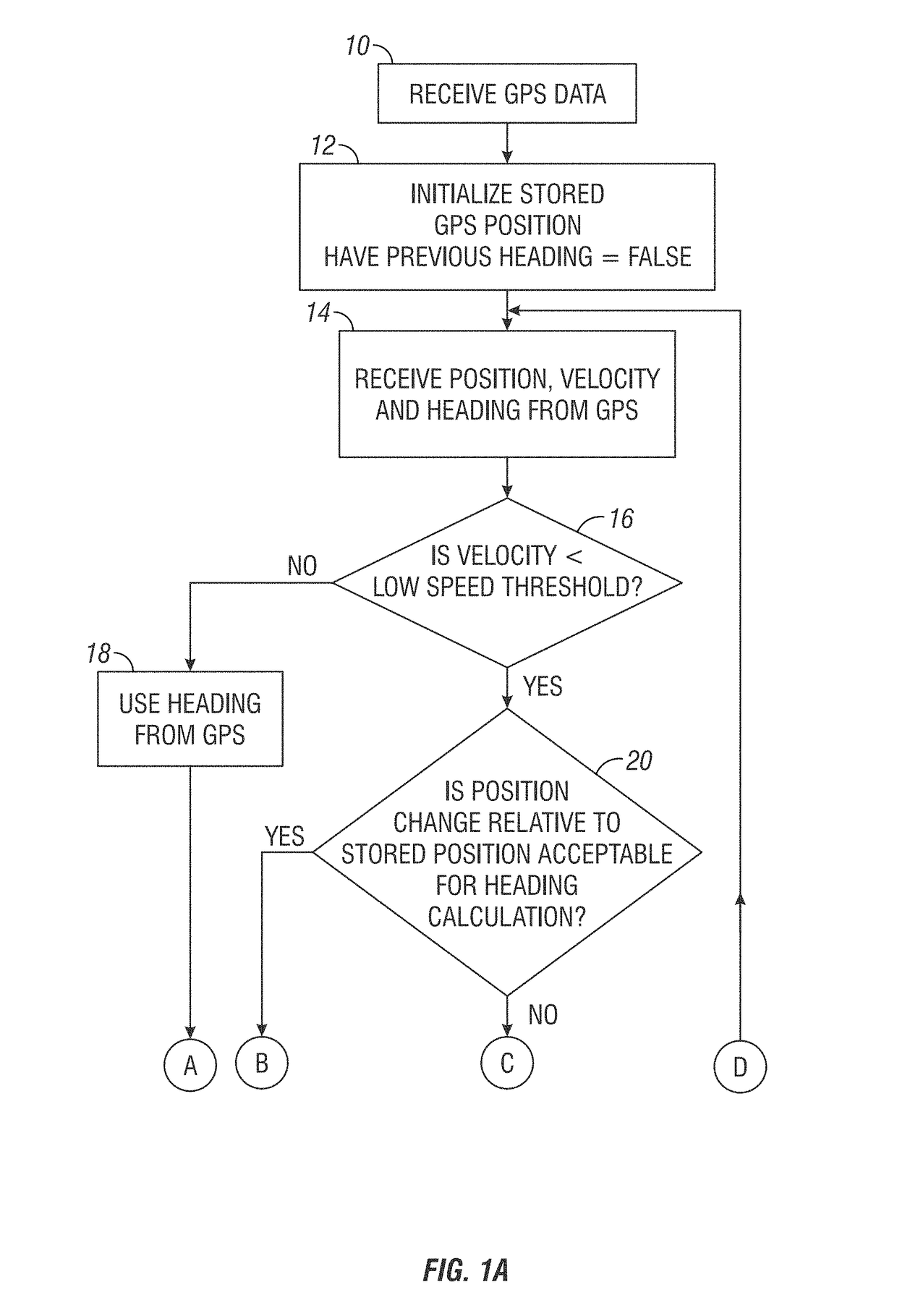Low speed heading measurement
a technology of low speed and heading measurement, applied in the direction of vehicle position/course/altitude control, process and machine control, instruments, etc., can solve the problems of equipment adding significant cost, increasing the error of heading measurement, so as to improve the accuracy of navigation system, accurate heading measurement, and improve the effect of steering control
- Summary
- Abstract
- Description
- Claims
- Application Information
AI Technical Summary
Benefits of technology
Problems solved by technology
Method used
Image
Examples
examples 1
B. Method Examples 1
[0033]A first concept of this invention is relatively simple: a new heading will not be calculated from the GPS coordinates until there has been a sufficient change in position to allow a calculation with acceptable error. To begin, the current GPS coordinates are stored in memory. Then at each GPS update, the change in position relative to the stored GPS coordinates is determined. If the change in position is less than a desired threshold, then the heading is not calculated using the new GPS position. When at a GPS update, the change in position relative to the stored GPS coordinates exceeds a threshold, a new heading is calculated using the current and stored GPS positions. The stored GPS position will then be updated.
[0034]A problem with this approach is that at very low speeds it may be several GPS update periods until a new heading is determined. If the vehicle is being steered in a tight turn during this time, the heading measurement will lag the actual hea...
example 2
C. Method Example 2
[0040]FIG. 1A and FIG. 1B illustrate a flow diagram of one example of a method for determining heading. The method allows for the heading from the GPS to be used when not at low speed. If at a low speed then instead of using the heading from the GPS, a heading is calculated. Under one set of conditions the heading can be calculated from GPS positions, under another set of conditions a heading change can be calculated and the previous heading calculation can be updated.
[0041]In step 10 GPS data is received. In step 12 an initialization is performed to initialize the stored GPS position and set the flag Have Previous Heading to false. In step 14 position, velocity and heading from the GPS is received. In step 16 a determination is made as to whether the velocity is less than a low speed threshold. If not, then in step 18 the heading from the GPS will be used and then in step 26 (See FIG. 1B) the Have Previous Heading flag is set to true.
[0042]Returning to FIG. 1A, s...
example 3
D. Method Example 3
[0043]FIG. 2A and FIG. 2B illustrate a flow diagram for an alternative process. The process shown in FIGS. 2A and 2B is similar to that shown in FIG. 1A and FIG. 1B except that the heading change is calculated in a different manner. In FIG. 2B, step 30 a determination is made as to whether the flag Have Previous Heading is true or not. If it is, then in step 33 the yaw rate is received. Next, in step 35, the heading change is calculated from the yaw rate and the GPS update period.
E. System Example 1
[0044]FIG. 3 illustrates a block diagram of agricultural equipment 30 configured with low speed heading measurement. A GPS or other location receiver 32 is shown. Information from the GPS receiver may include latitude and longitude, velocity, and heading. Instead of using latitude and longitude directly, the processor may convert latitude and longitude into X, Y coordinates or into another coordinate system. Also, although velocity may be provided from the GPS receiver ...
PUM
 Login to View More
Login to View More Abstract
Description
Claims
Application Information
 Login to View More
Login to View More - R&D
- Intellectual Property
- Life Sciences
- Materials
- Tech Scout
- Unparalleled Data Quality
- Higher Quality Content
- 60% Fewer Hallucinations
Browse by: Latest US Patents, China's latest patents, Technical Efficacy Thesaurus, Application Domain, Technology Topic, Popular Technical Reports.
© 2025 PatSnap. All rights reserved.Legal|Privacy policy|Modern Slavery Act Transparency Statement|Sitemap|About US| Contact US: help@patsnap.com



